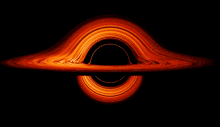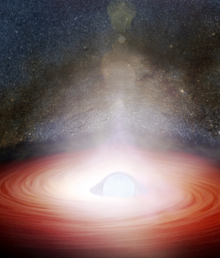User:Robincarpenter4444/NuSTAR
Spin measurement of a supermassive black hole
By measuring the frequency change of X-ray light emitted from the black hole corona, NuSTAR was able to view material from the corona be drawn closer to the event horizon. This caused inner portions of the black hole's accretion disk to be illuminated with X-rays, allowing this is elusive region to be studied by astronomers for spin rates.[1]
Measurement of temperature variations of AGN wind[edit]
In March 2nd of 2017, NuSTAR published an article to Nature detailing observations of wind temperature variations around AGN IRAS 13224−3809. By detecting periodic absences of absorption lines in the X-ray spectrum from the accretion disk winds, NuSTAR and XMM-Newton observed heating and cooling cycles of the relativistic winds leaving the accretion disk.[2]
Detection of light reflecting behind a black hole[edit]

NuSTAR and XMM-Newton detected x-ray radiation that was emitted behind the supermassive black hole within Seyfert 1 galaxy I Zwicky 1. Upon studying the flashes of light emitted by the corona of the black hole, researchers noticed that some detected light arrived to the detector later than the rest, with a corresponding change in frequency. The Stanford University team of scientists that led the study concluded that this change was directly attributable to radiation from the flash reflecting off of the accretion disk on the opposing side of the black hole. The path of this reflected light was bent by the high spacetime curvature, directed to the detector after the initial flash.[3]
Ultra-luminous neutron star breaking the Eddington limit[edit]

In April 6th of 2023, the NuSTAR team confirmed that neutron star M82 X-2 was emitting more radiation than was physically thought possible due to the Eddington limit, officially labeling it as an Ultraluminous X-ray source (ULX).[4]
References[edit]
- ^ Administrator, NASA Content (2015-11-20). "NASA's NuSTAR Helps Solve Riddle of Black Hole Spin". NASA. Retrieved 2023-04-24.
- ^ Parker, Michael L.; Pinto, Ciro; Fabian, Andrew C.; Lohfink, Anne; Buisson, Douglas J. K.; Alston, William N.; Kara, Erin; Cackett, Edward M.; Chiang, Chia-Ying; Dauser, Thomas; De Marco, Barbara; Gallo, Luigi C.; Garcia, Javier; Harrison, Fiona A.; King, Ashley L. (2017-03). "The response of relativistic outflowing gas to the inner accretion disk of a black hole". Nature. 543 (7643): 83–86. doi:10.1038/nature21385. ISSN 0028-0836.
{{cite journal}}: Check date values in:|date=(help) - ^ Wilkins, D. R.; Gallo, L. C.; Costantini, E.; Brandt, W. N.; Blandford, R. D. (2021-07-28). "Light bending and X-ray echoes from behind a supermassive black hole". Nature. 595 (7869): 657–660. doi:10.1038/s41586-021-03667-0. ISSN 0028-0836.
- ^ Jörn, Bachetti, Matteo Heida, Marianne Maccarone, Thomas Huppenkothen, Daniela Israel, Gian Luca Barret, Didier Brightman, Murray Brumback, McKinley Earnshaw, Hannah P. Forster, Karl Fürst, Felix Grefenstette, Brian W. Harrison, Fiona A. Jaodand, Amruta D. Madsen, Kristin K. Middleton, Matthew Pike, Sean N. Pilia, Maura Poutanen, Juri Stern, Daniel Tomsick, John A. Walton, Dominic J. Webb, Natalie Wilms, (2021-12-01). Orbital decay in M82 X-2. OCLC 1363556444.
{{cite book}}: CS1 maint: extra punctuation (link) CS1 maint: multiple names: authors list (link)
https://www.nustar.caltech.edu/news/nustar170301
The response of relativistic outflowing gas to the inner accretion disk of a black hole
